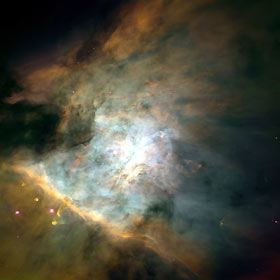
Enregistrez gratuitement cette image
en 800 pixels pour usage maquette
(click droit, Enregistrer l'image sous...)
|
|
Réf : S02624
Thème :
Nébuleuses (144 images)
Titre : The Orion Nebula
Description : (La description de cette image n'existe qu'en anglais)
This spectacular color panorama of the center the Orion nebula is one of the largest pictures ever assembled from individual images taken with NASA's Hubble Space Telescope. The picture, seamlessly composited from a mosaic of 15 separate fields, covers an area of sky about five percent the area covered by the full Moon. The seemingly infinite tapestry of rich detail revealed by Hubble shows a churning turbulent star factory set within a maelstrom of flowing, luminescent gas. Though this 2.5 light-years wide view is still a small portion of the entire nebula, it includes almost all of the light from the bright glowing clouds of gas and a star cluster associated with the nebula. The mosaic reveals at least 153 glowing protoplanetary disks (first discovered with the Hubble in 1992, and dubbed 'proplyds') that are believed to be embryonic solar systems that will eventually form planets. (Our solar system has long been considered the relic of just such a disk that formed around the newborn Sun). The proplyds that are closest to the Trapezium stars (image center) are shedding some of their gas and dust. The pressure of starlight from the hottest stars forms 'tails' which act like wind vanes pointing away from the Trapezium. These tails result from the light from the star pushing the dust and gas away from the outside layers of the proplyds. In addition to the luminescent proplyds, seven disks are silhouetted against the bright background of the nebula. Located 1,500 light-years away, along our spiral arm of the Milky Way, the Orion nebula is located in the middle of the sword region of the constellation Orion the Hunter, which dominates the early winter evening sky at northern latitudes.
|
|

